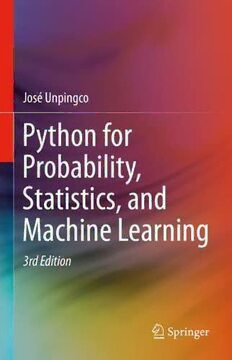Table Of ContentJosé Unpingco
Python for
Probability,
Statistics, and
Machine Learning
Third Edition
Python for Probability, Statistics, and Machine
Learning
José Unpingco
Python for Probability,
Statistics, and Machine
Learning
Third Edition
JoséUnpingco
SanDiego,CA,USA
ISBN978-3-031-04647-6 ISBN978-3-031-04648-3 (eBook)
https://doi.org/10.1007/978-3-031-04648-3
1stedition:©SpringerInternationalPublishingSwitzerland2016
2ndedition:©SpringerNatureSwitzerlandAG2019,correctedpublication2019
3rdedition:©TheEditor(s)(ifapplicable)andTheAuthor(s),underexclusivelicensetoSpringerNature
SwitzerlandAG2022
Thisworkissubjecttocopyright.AllrightsaresolelyandexclusivelylicensedbythePublisher,whether
thewholeorpartofthematerialisconcerned,specificallytherightsoftranslation,reprinting,reuse
ofillustrations,recitation,broadcasting,reproductiononmicrofilmsorinanyotherphysicalway,and
transmissionorinformationstorageandretrieval,electronicadaptation,computersoftware,orbysimilar
ordissimilarmethodologynowknownorhereafterdeveloped.
Theuseofgeneraldescriptivenames,registerednames,trademarks,servicemarks,etc.inthispublication
doesnotimply,evenintheabsenceofaspecificstatement,thatsuchnamesareexemptfromtherelevant
protectivelawsandregulationsandthereforefreeforgeneraluse.
Thepublisher,theauthors,andtheeditorsaresafetoassumethattheadviceandinformationinthisbook
arebelievedtobetrueandaccurateatthedateofpublication.Neitherthepublishernortheauthorsor
theeditorsgiveawarranty,expressedorimplied,withrespecttothematerialcontainedhereinorforany
errorsoromissionsthatmayhavebeenmade.Thepublisherremainsneutralwithregardtojurisdictional
claimsinpublishedmapsandinstitutionalaffiliations.
ThisSpringerimprintispublishedbytheregisteredcompanySpringerNatureSwitzerlandAG
Theregisteredcompanyaddressis:Gewerbestrasse11,6330Cham,Switzerland
ToIrene,Nicholas,andDaniella, foralltheir
patientsupport.
Preface to the Third Edition
ThisthirdeditionisupdatedforPythonversion3.8+butdoesnotuseanynewsyntax
andshouldbecompatiblewithPython3.6+also.Moreimportantly,manyexisting
sectionshavebeenrevisedbasedonfeedbackfromthefirstandsecondversions.The
book has been adopted into university-level curricula in data science and machine
learning worldwide, including the University of California, San Diego. It has also
been translated into multiple languages. With this in mind, I reedited significant
portionsforclaritytohopefullyeasethetranslationburdenofthiseditionandmake
iteasiertounderstandoverall.Almostallthefigureshavebeenupdatedforclarity.
Thestatisticschapterhasdoubledinsizeandnowcoversimportantbuthard-to-
find material, such as categorical data analysis and missing data imputation. The
machinelearningchapterhasbeenupdated,andnewsectionscoveringgradienttree
boosting have been added, along with a section on interpreting machine learning
models. The introduction now includes a discussion of the Xarray module for
multidimensionaldataframes.Overall,thebookisnowaboutone-thirdlargerthan
thesecondedition.
Asbefore,therearemoreProgrammingTipsthattheillustrateeffectivePython
modulesandmethodsforscientificprogrammingandmachinelearning.Thereare
over 650 run-able code blocks that have been tested for accuracy, so you can try
these out for yourself in your own codes. This edition features over 200 graphical
visualizationsgeneratedusingPythonthatillustratetheconceptsthataredeveloped
both in code and in mathematics. We also discuss and use key Python modules,
suchasNumpy,Scikit-learn,Sympy,Scipy,Lifelines,CvxPy,Theano,Matplotlib,
Pandas,Tensorflow,Statsmodels,Xarray,Seaborn,andKeras.
As with the first and second editions, all of the key concepts are developed
mathematically and are reproducible in the given Python, to provide the reader
multipleperspectivesonthematerial.Thisbookisnotdesignedtobeexhaustiveand
reflectstheauthor’seclecticindustrialbackground.Thefocusremainsonconcepts
and fundamentals for day-to-day work using Python in the most expressive way
possible. You can reach the author with comments at github.com/unpingco
byopeninganissueontheproject.
vii
viii PrefacetotheThirdEdition
Acknowledgements I would like to acknowledge the Python community as a
whole, for all their contributions that made this book possible. Hans Petter Lang-
tangen was the author of the Doconce [22] document preparation system that was
usedtowritethistext.ThankstoGeoffreyPoore[36]forhisworkwithPythonTeX
and,bothkeytechnologieswereusedtoproducethisbook.
SanDiego,CA,USA JoséUnpingco
March,2022
Preface to the Second Edition
ThissecondeditionisupdatedforPythonversion3.6+.Furthermore,manyexisting
sections have been revised for clarity based on feedback from the first version.
The book is now over 30 percent larger than the original with new material about
important probability distributions, including key derivations and illustrative code
samples. Additional important statistical tests are included in the statistics chapter
includingtheFisherexacttestandtheMann-Whitney-WilcoxonTest.Anewsection
onsurvivalanalysishasbeenincluded.Themostsignificantadditionisthesection
ondeeplearningforimageprocessingwithadetaileddiscussionofgradientdescent
methods that underpin all deep learning work. There is also substantial discussion
regarding generalized linear models. As before, there are more Programming Tips
thattheillustrateeffectivePythonmodulesandmethodsforscientificprogramming
andmachinelearning.Thereare445run-ablecodeblocksthathavebeentestedfor
accuracy,soyoucantrytheseoutforyourselfinyourowncodes.Over158graphical
visualizations (almost all generated using Python) illustrate the concepts that are
developed both in code and in mathematics. We also discuss and use key Python
modules, such as Numpy, Scikit-learn, Sympy, Scipy, Lifelines, CvxPy, Theano,
Matplotlib,Pandas,Tensorflow,Statsmodels,andKeras.
As with the first edition, all of the key concepts are developed mathematically
and are reproducible in Python, to provide the reader multiple perspectives on the
material. There are multiple As before, this book is not designed to be exhaustive
and reflects the author’s eclectic industrial background. The focus remains on
conceptsandfundamentalsforday-to-dayworkusingPythoninthemostexpressive
waypossible.
ix
Preface to the First Edition
This book will teach you the fundamentals concepts that underpin probability and
statisticsandillustratehowtheyrelatetomachinelearningviathePythonlanguage
and its powerful extensions. This is not a good first book in any of these topics,
becauseweassumethatyoualreadyhadadecentundergraduate-levelintroduction
to probability and statistics. Furthermore, we also assume that you have a good
grasp of the basic mechanics of the Python language itself. Having said that, this
bookisappropriateifyouhavethisbasicbackgroundandwanttolearnhowtouse
thescientificPythontoolchaintoinvestigatethesetopics.Ontheotherhand,ifyou
are comfortable with Python, perhaps through working in another scientific field,
thenthisbookwillteachyouthefundamentalsofprobabilityandstatisticsandhow
to use these ideas to interpret machine learning methods. Likewise, if you are a
practicingengineerusingacommercialpackage(e.g.,Matlab,IDL),thenyouwill
learn how to effectively use the scientific Python toolchain by reviewing concepts
youarealreadyfamiliarwith.
The most important feature of this book is that everything in it is reproducible
usingPython.Specifically,allofthecode,allofthefigures,and(mostof)thetext
are available in the downloadable supplementary materials that correspond to this
bookasIPythonNotebooks.IPythonNotebooksareliveinteractivedocumentsthat
allow you to change parameters, recompute plots, and generally tinker with all of
the ideas and code in this book. I urge you to download these IPython Notebooks
and follow along with the text to experiment with the topics covered. I guarantee
doing this will boost your understanding, because the IPython Notebooks allow
for interactive widgets, animations, and other intuition-building features that help
make many of these abstract ideas concrete. As an open-source project, the entire
scientific Python toolchain, including the IPython Notebook, is freely available.
Having taught this material for many years, I am convinced that the only way to
learnistoexperimentasyougo.Thetextprovidesinstructionsonhowtogetstarted
installingandconfiguringyourscientificPythonenvironment.
xi
xii PrefacetotheFirstEdition
This book is not designed to be exhaustive and reflects the author’s eclectic
background in industry. The focus is on fundamentals and intuitions for day-to-
day work, especially when you must explain the results of your methods to a
nontechnical audience. We have tried to use the Python language in the most
expressivewaypossiblewhileencouraginggoodPythoncodingpractices.

